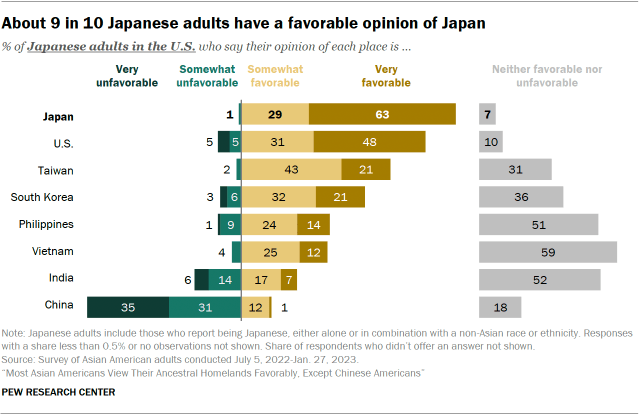In this report, we are unable to report on subgroup differences among Japanese adults in the U.S. This is because the sample included too few Japanese adults to make reliable estimates of smaller demographic subgroups (e.g., Japanese adults under 50, Japanese adults with some college experience or less, etc.).
For example, in the 2022-23 survey of Asian Americans, we conducted 81 raw interviews with foreign-born Japanese adults. That yields an effective sample size of 33 and a 95% confidence level margin of error (which assumes a reported percentage of 50%) of +/- 17.2 percentage points. This does not fulfill the Center’s requirements for responsible reporting on small subgroups. For more information, read our explainer on why we display margins of error in some graphics.
Nearly all Japanese adults in the U.S. (92%) say they have a favorable opinion of Japan, including 63% who have a very favorable view. This is a more favorable rating than any other place asked about in the survey. And Japanese adults’ views of Japan are somewhat more positive than among other Asian adults,9 67% of whom say they have a positive view of Japan.
Though about nine-in-ten Japanese adults say they have a favorable opinion of their ancestral homeland, only about a quarter say they would ever move to Japan, compared with 72% who say they would not.
Japanese Americans have largely positive views of the United States (79%) and Taiwan (64%). In the case of the U.S., around half even report very favorable views (48%), our survey analysis finds.

“[W]hen [people] find out I am Japanese – in our generation, Japan was a technological powerhouse at one time, like Sony, so they say, ‘Japan is great, isn’t it? Their technology is great.’ Now such conversation happens less often. So that presence of Japan is becoming the past, I feel. [Another] thing is about World War II. I’m over 60 years old now, so I feel World War II is closer to me than younger people. When I talk to older people here, they often mention the war. Like they were in Okinawa as a soldier, or served in the Korean War, they talk about their history. So the war-related matters come up in my mind.”
– Immigrant man of Japanese origin, age 62 (translated from Japanese)
About half of Japanese adults (53%) say they have a favorable view of South Korea, while 36% say their opinion is neither favorable nor unfavorable. Around one-in-ten have negative views of South Korea.
When it comes to Vietnam, Japanese Americans’ views are more neutral. About six-in-ten say their opinion of Vietnam is neither favorable nor unfavorable, though a higher share say their opinion is favorable than unfavorable (37% vs. 4%).
“[Japan is an] ally. Unlike China, America and Japan have been primary allies for a long time. They are allies, not enemies.”
– Immigrant woman of Japanese origin, age 45 (translated from Japanese)
About half of Japanese adults also have a neutral opinion of India and the Philippines (52% and 51%, respectively). In the case of India, similar shares report favorable and unfavorable views (24% and 21%). In the case of the Philippines, though, the balance of opinion is more positive than negative (38% vs. 10%).
Like some other Asian origin groups, Japanese Americans view China the most negatively of all the places asked about. Two-thirds of Japanese adults (66%) say they have an unfavorable opinion of the country. Similar shares say their view is favorable or neutral (14% and 18%).